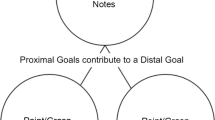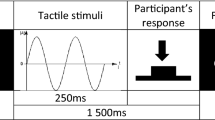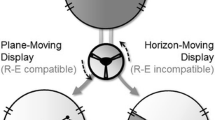Abstract
Observing another human’s actions influences action planning, but what about merely anticipating them? In joint action settings where a partner’s subsequent actions are a consequence of one’s own actions, such contingent partner reactions can be regarded as action effects. Therefore, just like automatic effects they might facilitate those of a person’s actions that overlap with them in relevant features. In Experiments 1 and 2, the spatial compatibility of contingent partner reactions was manipulated and compared with the influence of automatic effects. Experiment 1 used a simplistic scenario in which lateral keypress actions by the subject were responded to by mouse movements of a partner producing spatially compatible or incompatible visual effects. Experiment 2 transferred the paradigm to a more complex task in which subjects manually relocated virtual objects on a multi-touch display, and these or other objects were subsequently manipulated by the partner. In Experiment 1, compatible partner reactions speeded up subjects’ preceding actions, whereas in Experiment 2 the influence was not statistically reliable. To test whether influences of partner reaction compatibility could be found in such naturalistic settings at all, Experiment 3 also used a multi-touch setting but varied temporal instead of spatial compatibility, which has several methodological advantages. This time, a compatibility effect emerged in subjects’ movement initiation times, whereas contrast effects were found for movement durations. These findings indicate that the principles of ideomotor action control can be extended to joint action settings. At the same time, they also emphasize the importance of task features in determining whether our own behaviour is influenced by anticipations of another person’s reactions.




Similar content being viewed by others
Notes
The relative spatial positioning of the participants differed between the experiments (next to each other vs. opposite sides). This resulted from the different affordances posed by the technologies (standard computer monitor vs. multi-touch table) and thus was mainly due to practical considerations. However, note that whereas the position of the participants’ bodies differed, the position and movement direction of their spatial indicator (i.e. mouse cursor in Experiment 1 and index finger in Experiment 2) were identical.
Note that in the present multi-touch setup, the virtual objects lacked any haptic boundaries and thus did not pose clear restrictions on subjects’ movement amplitudes. In consequence, subjects did not slow down when approaching the end of the object, but extended their swipe gesture way beyond its boundary. Therefore, any speed changes within the measured area were fairly monotonic.
A previous study examining the temporal compatibility of action effects (Kunde, 2003) analysed the data in a different way, by computing the interaction of action duration and effect duration. This procedure was not adopted in Experiment 3 to make the analysis procedure consistent with that used in Experiments 1 and 2. However, to facilitate the comparison with Kunde’s study, the data were re-analysed accordingly: initiation times from compatible and incompatible blocks were collapsed across the two choice conditions and a repeated measures ANOVA entered with the factors action duration and CPR duration. There was a main effect of action duration, F(1,23) = 163.576, p < 0.001, η 2p = 0.877, and an interaction with CPR duration, F(1,23) = 6.753, p = 0.016, η 2p = 0.227. Fast actions were initiated more quickly than slow actions, and compatible mappings (i.e. fast actions being followed by fast CPR and slow movements by slow CPR) led to shorter initiation times than incompatible mappings. However, the main effect of CPR duration was absent, F < 1, indicating that initiation times for actions that triggered fast effects were not generally shorter than those triggering slow effects. The latter result diverges from previous findings (Kunde, 2003).
Analogous to the initiation times, movement durations were re-analysed with the factors action duration and CPR duration. There were main effects of action duration, F(1,23) = 149.705, p < 0.001, η 2p = 0.867, CPR duration, F(1,23) = 7.520, p = 0.012, η 2p = 0.246, and an interaction, F(1,23) = 6.062, p = 0.022, η 2p = 0.209. Fast movements were performed faster than slow movements, and movements with slow CPR were performed faster than movements with fast CPR. Moreover, with a compatible mapping movements were performed faster than with an incompatible mapping. The presence of an interaction for the movement durations is in contrast with the findings of Kunde (2003).
References
Aglioti, S. M., Cesari, P., Romani, M., & Urgesi, C. (2008). Action anticipation and motor resonance in elite basketball players. Nature Neuroscience, 11(9), 1109–1116. doi:10.1038/nn.2182.
Ansorge, U. (2002). Spatial intention–response compatibility. Acta Psychologica, 109(3), 285–299. doi:10.1016/S0001-6918(01)00062-2.
Aschersleben, G., & Prinz, W. (1997). Delayed auditory feedback in synchronization. Journal of Motor Behavior, 29(1), 35–46. doi:10.1080/00222899709603468.
Atmaca, S., Sebanz, N., & Knoblich, G. (2011). The joint flanker effect: sharing tasks with real and imagined co-actors. Experimental Brain Research, 211(3–4), 371–385. doi:10.1007/s00221-011-2709-9.
Bertenthal, B. I., Longo, M. R., & Kosobud, A. (2006). Imitative response tendencies following observation of intransitive actions. Journal of Experimental Psychology: Human Perception and Performance, 32(2), 210–225. doi:10.1037/0096-1523.32.2.210.
Blakemore, S. J., Goodbody, S. J., & Wolpert, D. M. (1998). Predicting the consequences of our own actions: the role of sensorimotor context estimation. Journal of Neuroscience, 18(18), 7511–7518.
Bouquet, C. A., Shipley, T. F., Capa, R. L., & Marshall, P. J. (2011). Motor contagion: goal-directed actions are more contagious than non-goal-directed actions. Experimental Psychology, 58(1), 71–78. doi:10.1027/1618-3169/a000069.
Brass, M., Bekkering, H., & Prinz, W. (2001). Movement observation affects movement execution in a simple response task. Acta Psychologica, 106(1–2), 3–22. doi:10.1016/S0001-6918(00)00024-X.
Catmur, C., & Heyes, C. (2013). Is it what you do, or when you do it? The roles of contingency and similarity in pro-social effects of imitation. Cognitive Science, 37(8), 1541–1552. doi:10.1111/cogs.12071.
Chaminade, T., Meary, D., Orliaguet, J.-P., & Decety, J. (2001). Is perceptual anticipation a motor simulation? A PET study. Neuroreport, 12(17), 3669–3674. doi:10.1097/00001756-200112040-00013.
Chartrand, T. L., & Bargh, J. A. (1999). The chameleon effect: the perception–behavior link and social interaction. Journal of Personality and Social Psychology, 76(6), 893–910. doi:10.1037/0022-3514.76.6.893.
Costantini, M., Ambrosini, A., & Sinigaglia, C. (2012). Does how I look at what you’re doing depend on what I’m doing? Acta Psychologica, 141(2), 199–204. doi:10.1016/j.actpsy.2012.07.012.
Csibra, G. (2007). Action mirroring and action understanding: an alternative account. In P. Haggard, Y. Rosetti, & M. Kawato (Eds.), Attention and performance (Vol. 22, pp. 435–459)., Sensorimotor foundations of higher cognition Oxford: Oxford University Press.
De Coster, L., Verschuere, B., Goubert, L., Tsakiris, M., & Brass, M. (2013). I suffer more from your pain when you act like me: being imitated enhances affective responses to seeing someone else in pain. Cognitive, Affective, and Behavioral Neuroscience, 13(3), 519–532. doi:10.3758/s13415-013-0168-4.
Dolk, T., Hommel, B., Colzato, L. S., Schütz-Bosbach, S., Prinz, W., & Liepelt, R. (2014). The joint Simon effect: a review and theoretical integration. Frontiers in Psychology, 5(5), 974. doi:10.3389/fpsyg.2014.00974.
Dolk, T., Hommel, B., Prinz, W., & Liepelt, R. (2013). The (not so) social Simon effect: a referential coding account. Journal of Experimental Psychology: Human Perception and Performance, 39(5), 1248–1260. doi:10.1037/a0031031.
Elsner, B., & Hommel, B. (2001). Effect anticipation and action control. Journal of Experimental Psychology: Human Perception and Performance, 27(1), 229–240. doi:10.1037/0096-1523.27.1.229.
Elsner, B., & Hommel, B. (2004). Contiguity and contingency in action–effect learning. Psychological Research, 68(2–3), 138–154. doi:10.1007/s00426-003-0151-8.
Flach, R., Press, C., Badets, A., & Heyes, C. (2010). Shaking hands: priming by social action effects. British Journal of Psychology, 101(4), 739–749. doi:10.1348/000712609X484595.
Flanagan, J. R., & Johansson, R. S. (2003). Action plans used in action observation. Nature, 424(6950), 769–771. doi:10.1038/nature01861.
Frischen, A., Bayliss, A. P., & Tipper, S. (2007). Gaze cueing of attention: visual attention, social cognition, and individual differences. Psychological Bulletin, 133(4), 694–724. doi:10.1037/0033-2909.133.4.694.
Gowen, E., & Poliakoff, E. (2012). How does visuomotor priming differ for biological and non-biological stimuli? A review of the evidence. Psychological Research, 76(4), 407–420. doi:10.1007/s00426-011-0389-5.
Graf, M., Reitzner, B., Corves, C., Casile, A., Giese, M., & Prinz, W. (2007). Predicting point-light actions in real-time. Neuroimage, 36(Supplement 2), T22–T32. doi:10.1016/j.neuroimage.2007.03.017.
Herwig, A., & Horstmann, G. (2011). Action–effect associations revealed by eye movements. Psychonomic Bulletin and Review, 18(3), 531–537. doi:10.3758/s13423-011-0063-3.
Herwig, A., Prinz, W., & Waszak, F. (2007). Two modes of sensorimotor integration in intention-based and stimulus-based actions. Quarterly Journal of Experimental Psychology, 60(11), 1540–1554. doi:10.1080/17470210601119134.
Heyes, C. (2013). Imitation - associative and context-dependent. In W. Prinz, M. Beisert, & A. Herwig (Eds.), Action science: Foundations of an emerging discipline. Cambridge: MIT Press.
Hoffmann, J., Lenhard, A., Sebald, A., & Pfister, R. (2009). Movements or targets: what makes an action in action–effect learning? Quarterly Journal of Experimental Psychology, 62(12), 2433–2449. doi:10.1080/17470210902922079.
Hommel, B. (1993). Inverting the Simon effect by intention: determinants of direction and extent of effects of irrelevant spatial information. Psychological Research/Psychologische Forschung, 55(4), 270–279. doi:10.1007/BF00419687.
Hommel, B. (2004). Coloring an action: intending to produce color events eliminates the Stroop effect. Psychological Research, 74–90(2–3), 74–90. doi:10.1007/s00426-003-0146-5.
Hommel, B. (2013). Ideomotor action control: On the perceptual grounding of voluntary actions and agents. In W. Prinz, M. Beisert, & A. Herwig (Eds.), Action science: Foundations of an emerging discipline (pp. 113–136). Cambridge: MIT Press.
Hommel, B., Müsseler, J., Aschersleben, G., & Prinz, W. (2001). The theory of event coding (TEC): a framework for perception and action planning. Behavioral and Brain Sciences, 24(5), 849–878. doi:10.1017/S0140525X01000103.
Iacoboni, M., Molnar-Szakacs, I., Gallese, V., Buccino, G., Mazziotta, J. C., & Rizzolatti, G. (2005). Grasping the intentions of others with one’s own mirror neuron system. PLoS Biology, 3(3), e79. doi:10.1371/journal.pbio.0030079.
Janczyk, M., Pfister, R., Crognale, M. A., & Kunde, W. (2012). Effective rotations: action effects determine the interplay of mental and manual rotations. Journal of Experimental Psychology: General, 141(3), 489–501. doi:10.1037/a0026997.
Janczyk, M., Yamaguchi, M., Proctor, R. W., & Pfister, R. (2015). Response–effect compatibility with complex actions: the case of wheel rotations. Attention, Perception, and Psychophysics, 77(3), 930–940. doi:10.3758/s13414-014-0828-7
Kiesel, A., & Hoffmann, J. (2004). Variable action effects: response control by context-specific effect anticipations. Psychological Research, 68(2–3), 155–162. doi:10.1007/s00426-003-0152-7.
Klapp, S. T. (1995). Motor response programming during simple choice reaction time: the role of practice. Journal of Experimental Psychology: Human Perception and Performance, 21(5), 1015–1027. doi:10.1037/0096-1523.21.5.1015.
Kourtis, D., Sebanz, N., & Knoblich, G. (2010). Favouritism in the motor system: social interaction modulates action simulation. Biology Letters, 6(6), 758–761. doi:10.1098/rsbl.2010.0478.
Kühn, S., Müller, B. C. N., van Baaren, R. B., Wietzker, A., Dijksterhuis, A., & Brass, M. (2010). Why do I like you when you behave like me? Neural mechanisms mediating positive consequences of observing someone being imitated. Social Neuroscience, 5(4), 384–392. doi:10.1080/17470911003633750.
Kunde, W. (2001). Response–effect compatibility in manual choice reaction tasks. Journal of Experimental Psychology: Human Perception and Performance, 27(2), 387–394. doi:10.1037/0096-1523.27.2.387.
Kunde, W. (2003). Temporal response–effect compatibility. Psychological Research, 67(3), 153–159. doi:10.1007/s00426-002-0114-5.
Kunde, W., Hoffmann, J., & Zellmann, P. (2002). The impact of anticipated action effects on action planning. Acta Psychologica, 109(2), 137–155. doi:10.1016/S0001-6918(01)00053-1.
Kunde, W., Koch, I., & Hoffmann, J. (2004). Anticipated action effects affect the selection, initiation and execution of actions. Quarterly Journal of Experimental Psychology, 57A(1), 87–106. doi:10.1080/02724980343000143.
Kunde, W., Lozo, L., & Neumann, R. (2011). Effect-based control of facial expressions: evidence from action–effect compatibility. Psychonomic Bulletin and Review, 18(4), 820–826. doi:10.3758/s13423-011-0093-x.
Liepelt, R., & Brass, M. (2010). Top-down modulation of motor priming by belief about animacy. Experimental Psychology, 57(3), 221–227. doi:10.1027/1618-3169/a000028.
Loehr, J. D., Sebanz, N., & Knoblich, G. (2013). Joint action: From perception-action links to shared representations. In W. Prinz, M. Beisert, & A. Herwig (Eds.), Action science: Foundations of an emerging discipline (pp. 333–356). Cambridge: MIT Press.
Longo, M. R., & Bertenthal, B. I. (2009). Attention modulates the specificity of automatic imitation to human actors. Experimental Brain Research, 192(4), 739–744. doi:10.1007/s00221-008-1649-5.
Newman-Norlund, R. D., van Schie, H. T., van Zuijlen, A. M. J., & Bekkering, H. (2007). The mirror neuron system is more active during complementary compared with imitative action. Nature Neuroscience, 10(7), 817–818. doi:10.1038/nn1911.
Nishitani, N., & Hari, R. (2000). Temporal dynamics of cortical representation for action. Proceedings of the National Academy of Sciences, 97(2), 913–918. doi:10.1073/pnas.97.2.913.
Pfeiffer, U. J., Timmermans, B., Bente, B., Vogeley, K., & Schilbach, L. (2012). A non-verbal turing test: differentiating mind from machine in gaze-based social interaction. PLoS ONE, 6(11), e27591. doi:10.1371/journal.pone.0027591.
Pfister, R., Dignath, D., Hommel, B., & Kunde, W. (2013). It takes two to imitate: anticipation and imitation in social interaction. Psychological Science, 24(10), 2117–2121. doi:10.1177/0956797613489139.
Pfister, R., Dolk, T., Prinz, W., & Kunde, W. (2014a). Joint response–effect compatibility. Psychonomic Bulletin and Review, 21(3), 817–822. doi:10.3758/s13423-013-0528-7.
Pfister, R., Janczyk, M., Wirth, R., Dignath, D., & Kunde, W. (2014b). Thinking with portals: revisiting kinematic cues to intention. Cognition, 133(2), 464–473. doi:10.1016/j.cognition.2014.07.012.
Pfister, R., Obhi, S. S., Rieger, M., & Wenke, D. (2014c). Action and perception in social contexts: intentional binding for social action effects. Frontiers in Human Neuroscience, 8, 667. doi:10.3389/fnhum.2014.00667.
Prinz, W. (1997). Perception and action planning. European Journal of Cognitive Psychology, 9(2), 129–154. doi:10.1080/713752551.
Raftery, A. E. (1995). Bayesian model selection in social research. In P. V. Marsden (Ed.), Sociological methodology (pp. 111–196). Cambridge: Blackwell.
Ramnani, N., & Miall, R. C. (2004). A system in the human brain for predicting the actions of others. Nature Neuroscience, 7(1), 85–90. doi:10.1038/nn1168.
Rotman, G., Troje, N. F., Johansson, R. S., & Flanagan, J. R. (2006). Eye movements when observing predictable and unpredictable actions. Journal of Neurophysiology, 96(3), 1358–1369. doi:10.1152/jn.00227.2006.
Rouder, J. N., Speckman, P. L., Sun, D., Morey, R. D., & Iverson, G. (2009). Bayesian t tests for accepting and rejecting the null hypothesis. Psychonomic Bulletin and Review, 16(2), 225–237. doi:10.3758/PBR.16.2.225.
Sartori, L., Bucchioni, G., & Castiello, U. (2013). When emulation becomes reciprocity. Social Cognitive and Affective Neuroscience, 8, 662–669. doi:10.1093/scan/nss044.
Sebanz, N., Knoblich, G., & Prinz, W. (2003). Representing others’ actions: just like one’s own? Cognition, 88(3), B11–B21. doi:10.1016/S0010-0277(03)00043-X.
Sparenberg, P., Springer, A., & Prinz, W. (2012). Predicting others’ actions: evidence for a constant time delay in action simulation. Psychological Research, 76(1), 41–49. doi:10.1007/s00426-011-0321-z.
Springer, A., Brandstädter, S., Liepelt, R., Birngruber, T., Giese, M., Mechsner, F., & Prinz, W. (2011). Motor execution affects action prediction. Brain and Cognition, 76(1), 26–36. doi:10.1016/j.bandc.2011.03.007.
Stanley, J., Gowen, E., & Miall, R. C. (2007). Effects of agency on movement interference during observation of a moving dot stimulus. Journal of Experimental Psychology: Human Perception and Performance, 33(4), 915–926. doi:10.1037/0096-1523.33.4.915.
Stürmer, B., Aschersleben, G., & Prinz, W. (2000). Correspondence effects with manual gestures and postures: a study of imitation. Journal of Experimental Psychology: Human Perception and Performance, 26(6), 1746–1759. doi:10.1037/0096-1523.26.6.1746.
Theeuwes, J., Kramer, A. F., Hahn, S., & Irwin, D. E. (1998). Our eyes do not always go where we want them to go: capture of the eyes by new objects. Psychological Science, 9(5), 379–385. doi:10.1111/1467-9280.00071.
Tsai, C. C., Kuo, W. J., Hung, D. L., & Tzeng, O. J. (2008). Action co-representation is tuned to other humans. Journal of Cognitive Neuroscience, 20(11), 2015–2024. doi:10.1162/jocn.2008.20144.
Van Baaren, R. B., Holland, R. W., Kawakami, K., & Van Knippenberg, A. (2004). Mimicry and prosocial behavior. Psychological Science, 15(1), 71–74. doi:10.1111/j.0963-7214.2004.01501012.x.
Verschoor, S. A., Eenshuistra, R. M., Kray, J., Biro, S., & Hommel, B. (2011). Explicit learning of arbitrary and non-arbitrary action–effect relations in adults and 4-year-olds. Frontiers in Psychology, 2, 354. doi:10.3389/fpsyg.2011.00354.
Watanabe, K. (2008). Behavioral speed contagion: automatic modulation of movement timing by observation of body movements. Cognition, 106(3), 1514–1524. doi:10.1016/j.cognition.2007.06.001.
Wiese, E., Wykowska, A., Zwickel, J., & Müller, H. J. (2012). I see what you mean: how attentional selection is shaped by ascribing intentions to others. PLoS ONE, 7(9), e45391. doi:10.1371/journal.pone.0045391.
Wolpert, D. M., Diedrichsen, J., & Flanagan, J. R. (2011). Principles of sensorimotor learning. Nature Reviews Neuroscience, 12(12), 739–751. doi:10.1038/nrn3112.
Wolpert, D. M., Doya, K., & Kawato, M. (2003). A unifying computational framework for motor control and social interaction. Philosophical Transactions of the Royal Society of London, B, 358(1431), 593–602. doi:10.1098/rstb.2002.1238.
Acknowledgments
I want to thank Dietrich Kammer and René Dang for programming the multi-touch experiments, as well as Jens R. Helmert and Sebastian Pannasch for continuously supporting my work. Parts of this research were funded by the German Research Foundation (MU 3749/1-1).
Author information
Authors and Affiliations
Corresponding author
Rights and permissions
About this article
Cite this article
Müller, R. Does the anticipation of compatible partner reactions facilitate action planning in joint tasks?. Psychological Research 80, 464–486 (2016). https://doi.org/10.1007/s00426-015-0670-0
Received:
Accepted:
Published:
Issue Date:
DOI: https://doi.org/10.1007/s00426-015-0670-0




